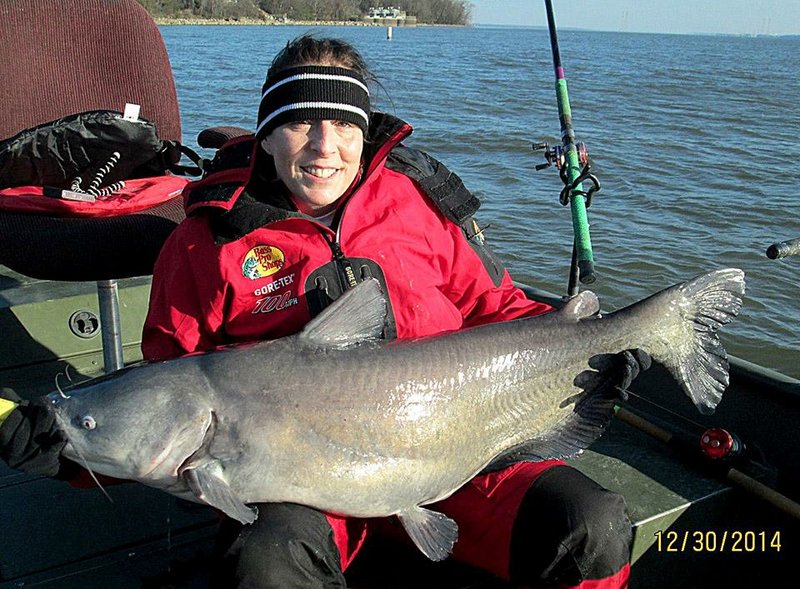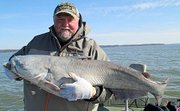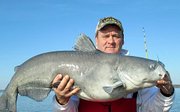A patient angler can catch a lot of big catfish during the winter in Arkansas.
Chris Fuller of Fayetteville, an accomplished Natural State catfisherman, pursues trophy catfish across the South and Midwest. The Arkansas River is a respectable site, and late fall and winter are some of the best times to hook big blue cats, he said. The key is patience, Fuller said, adding that several hours have to be spent in a spot instead of running around to multiple spots.
"If you know fish are there, don't leave them because they'll turn on at some point," Fuller said. "That's the way blues are. It's not that fast channel cat action like you see in the summertime. The fish are semi-dormant, but they are going to feed."
Like someone sitting on a couch watching a game.
"Put a plate of chicken in front of him, and sooner or later he's going to eat it," Fuller said.
It's easier to sit in a spot for hours if you have a reason to believe fish are there. Fuller said that modern electronics eliminate doubt because a good graph allows an angler to find and target an individual catfish.
"You're looking for big arcs," Fuller said. "There are people who can set a Lowrance graph to where catfish show red, and other fish show yellow or orange. It's a matter of fine-tuning your graph to give you a better idea of what you're seeing."
Sidescanning graphs are more versatile than traditional graphs, Fuller said.
"You can zoom in and see catfish over other fish," he said. "We've seen spoonbill and gar. You see a big body with a big needle nose sticking out, but for somebody using traditional two-dimensional sonar, it just looks like an arc."
During a recent outing on Alabama's Wheeler Lake, Fuller said he caught an 85-pound blue cat that he found with a sidescan graph.
In cold weather, big catfish are in deep water, Fuller said. That means they are in main channel bends and scour holes in depths of 25-40 feet. Deep water is more conducive to electronic scanning, he said.
Again, you scan for catfish and not bait. Fuller said that some anglers err by scanning for baitfish.
"A lot of people think that if they find bait, they'll find fish, but that's not always true with catfish," Fuller said. "They let the bait come to them. If they're deep, they're going to feed when a shad kill happens because it falls in front of them."
Too much food might be a problem on the Arkansas River right now, Fuller said. Catfish anglers that spend a lot of time on the water believe that a prolonged spell of freezing weather can cause a shad kill. There's so much for catfish to eat that cut bait and hooked live bait doesn't hold much appeal.
Before the cold weather hit, fishing was outstanding, especially in the Oklahoma portion of the river, fuller said. During one outing at Kerr Lake, Fuller said he and Sam White of Booneville caught four blue catfish that weighed a total of 178 pounds.
"We saw them on a graph," Fuller said. "They looked like Dalmatian dogs on that graph. The fish were just little white marks on the screen. There was just one big fish after another. It was pretty cool."
For trophy blues, the Arkansas River within our borders ranks lower than the Oklahoma section, and far lower than the Tennessee and Ohio rivers. The Arkansas is comparatively small, but Fuller said he's noticed fish are bigger in waters where commercial fishing is not allowed.
He said the Arkansas River west of Lock and Dam 13 at Barling is good for big fish. The restricted areas directly below the dams where boats are not allowed holds promise, he said. Getting a bait to them requires some ingenuity.
Anglers anchor at the restricted line, Fuller said, and put their bait on a remote-controlled boat. That boat takes the bait to a dropoff point and allows anglers to fish where they can't go or throw. That tactic is effective throughout the year, adding he did it all summer.
Finding bait right now can be as challenging as finding catfish. Fuller said he and his associates have been netting shad in depths of about 30 feet. Fuller prefers skipjack, and catches them near the Nuclear One plant on Lake Dardanelle.
"Once we get shad, we look for fish on the deeper banks," Fuller said. "We set up in about 5 to 10 feet on the edge and throw into the dropoffs and ledges."
The water will start getting warmer soon. With a string of warm days, Fuller recommends looking for fish on sun-drenched banks. A 3- to 4-degree difference will bring the fish shallow and the will stay there more than most, which is a reason bass anglers are hitting the banks.
Recent rains have put a strong current in the Arkansas River, so getting bait deep to catfish requires heavy weight.
"You can throw out three ounces, and suddenly your lines have moved to the back of the boat," Fuller said. "If we're fishing really deep in a lot of current, we're probably fishing six ounces."
It's been cold and windy lately, and it's always worse on the water. Dress in warm layers and be patient. Eventually, your reward will come.
Sports on 01/18/2015



